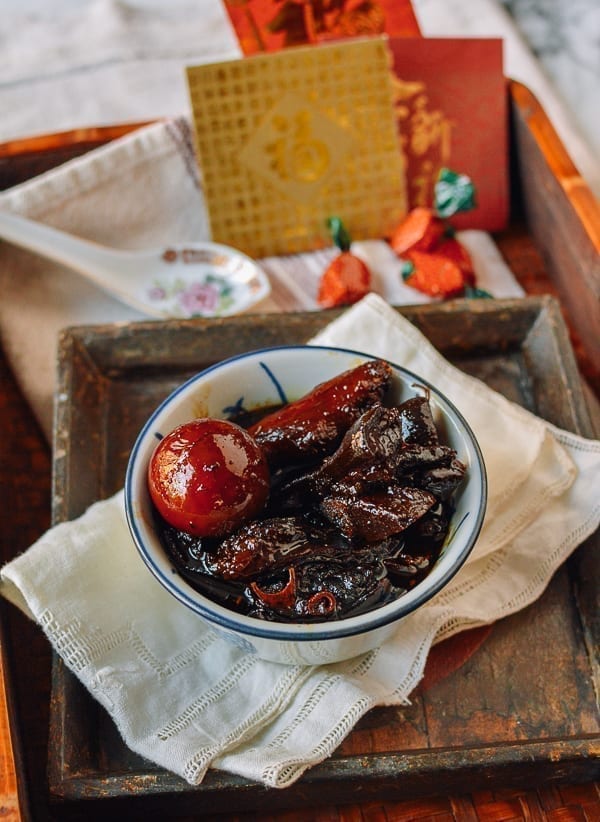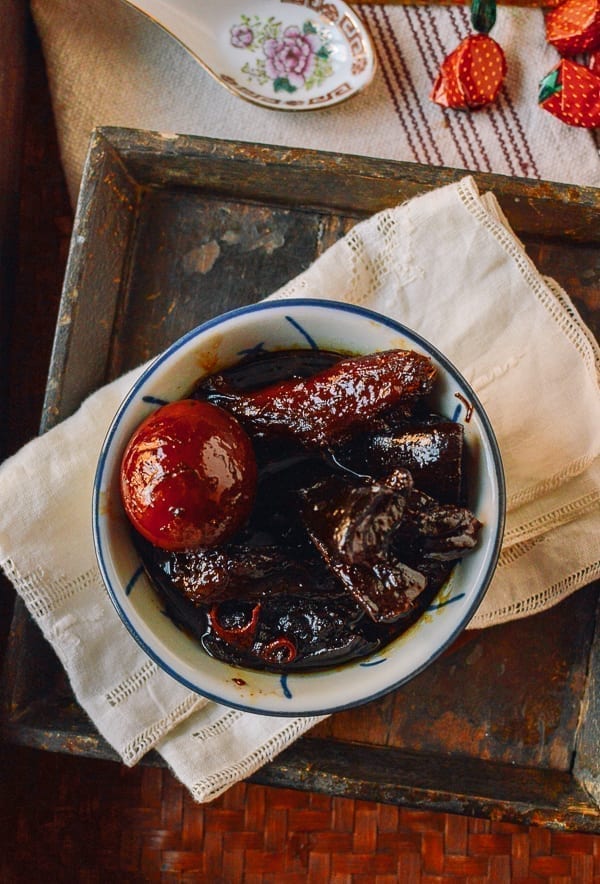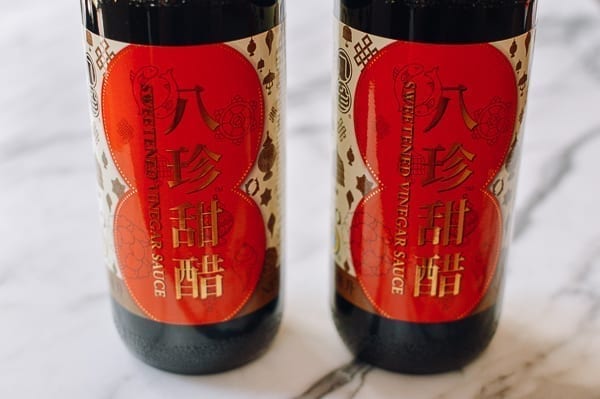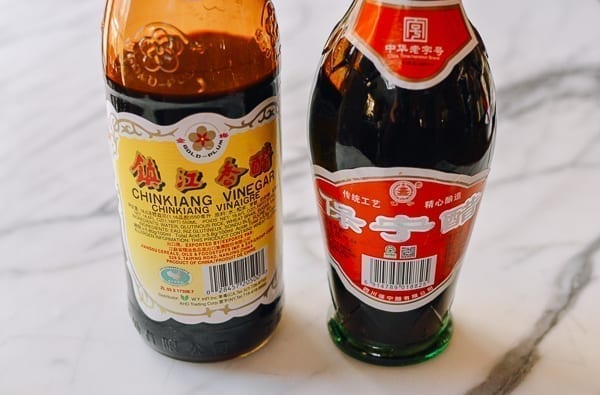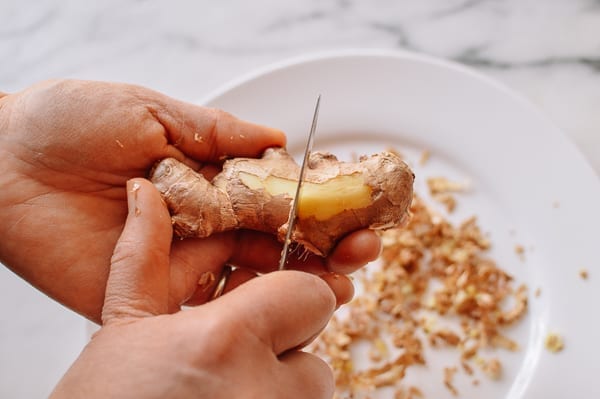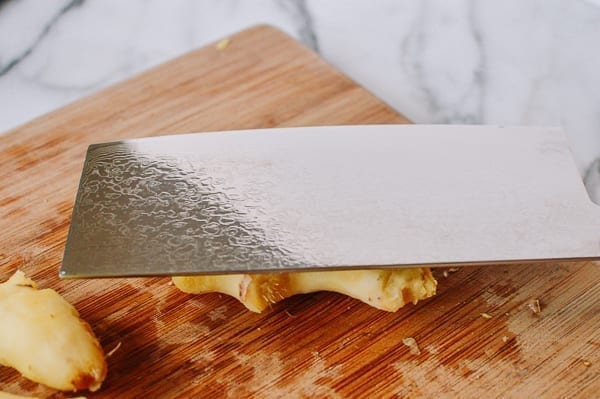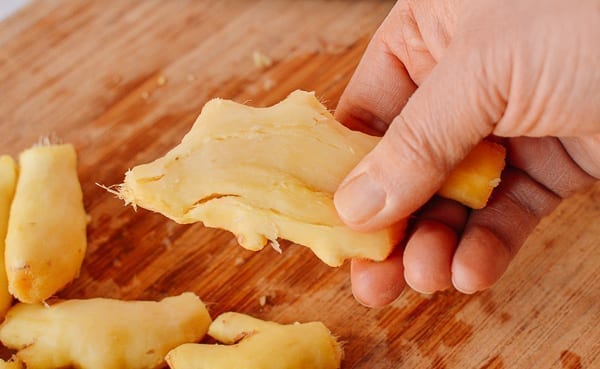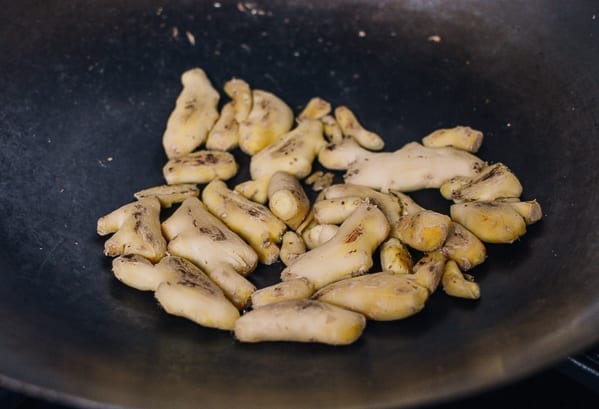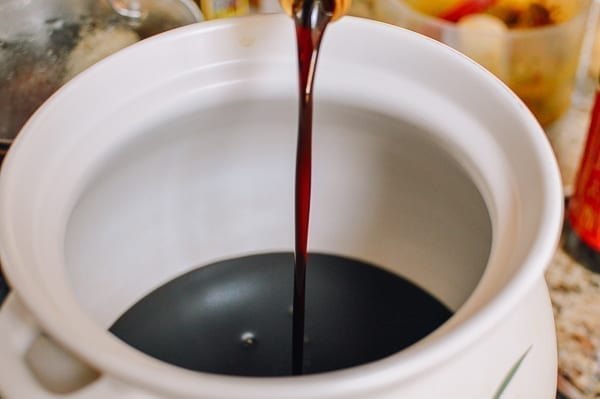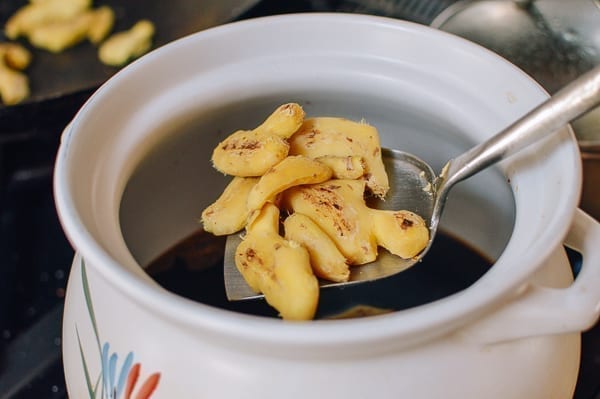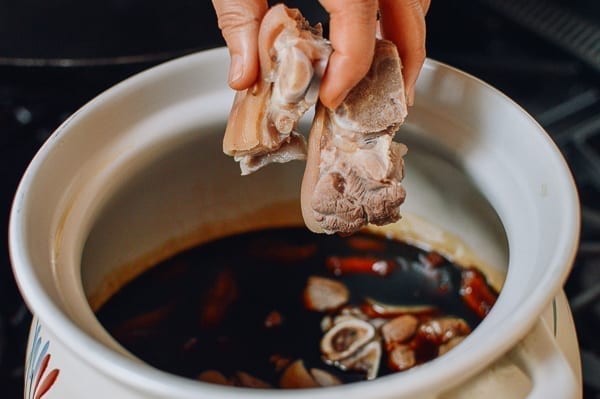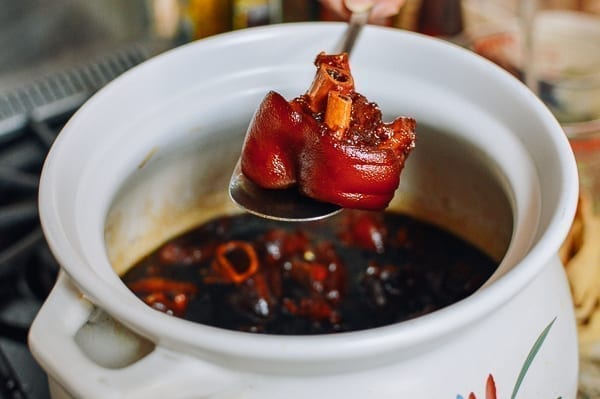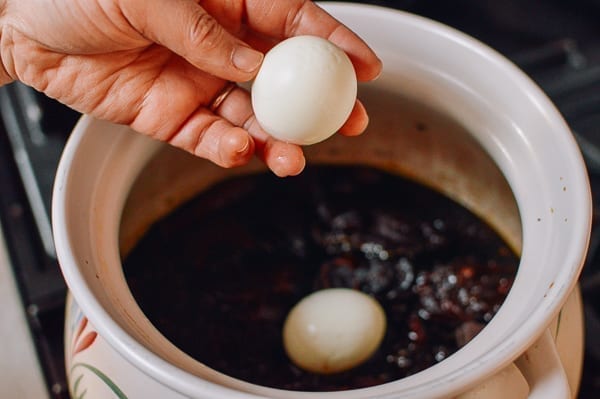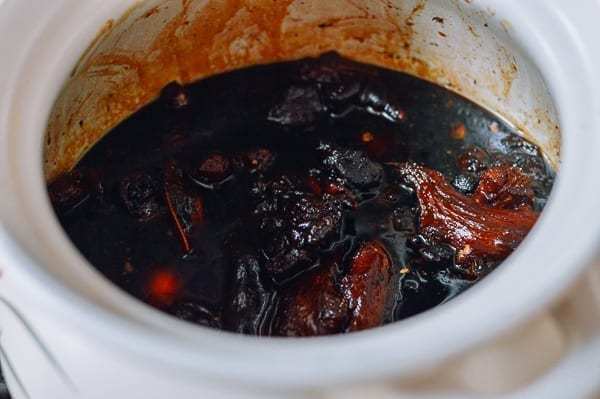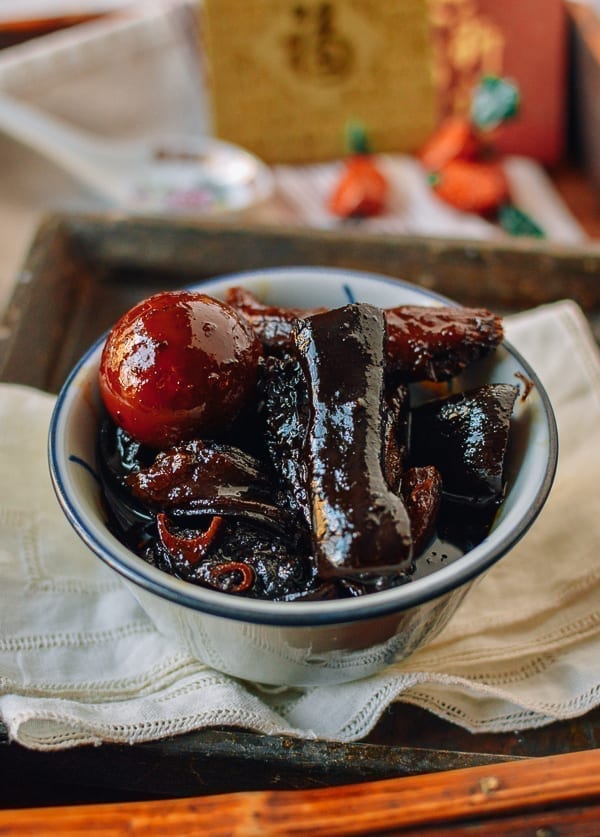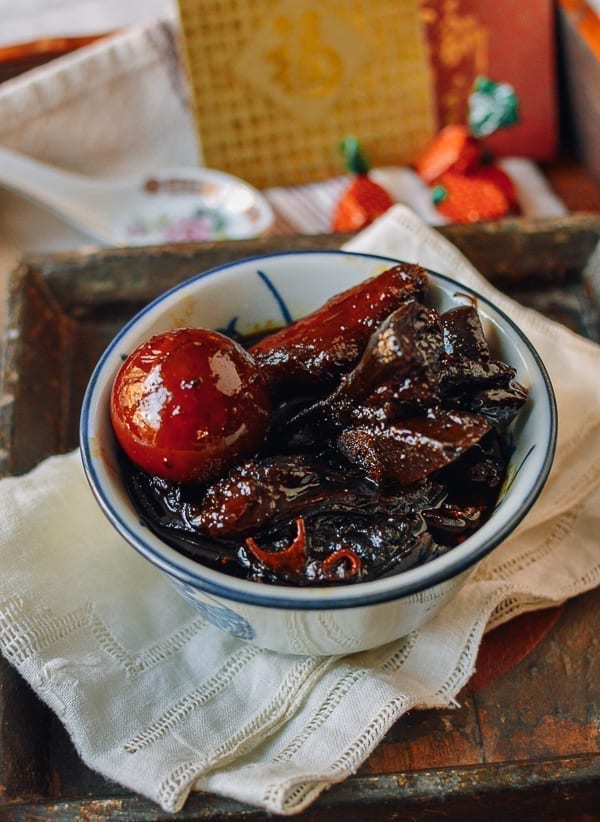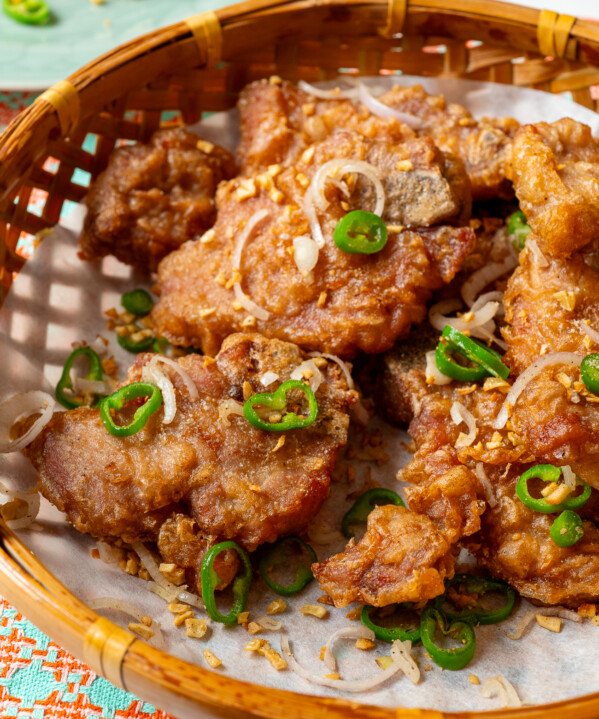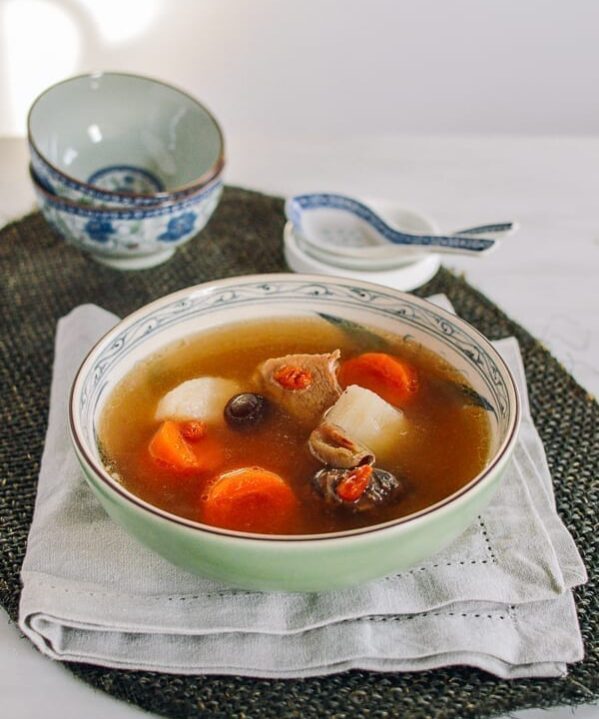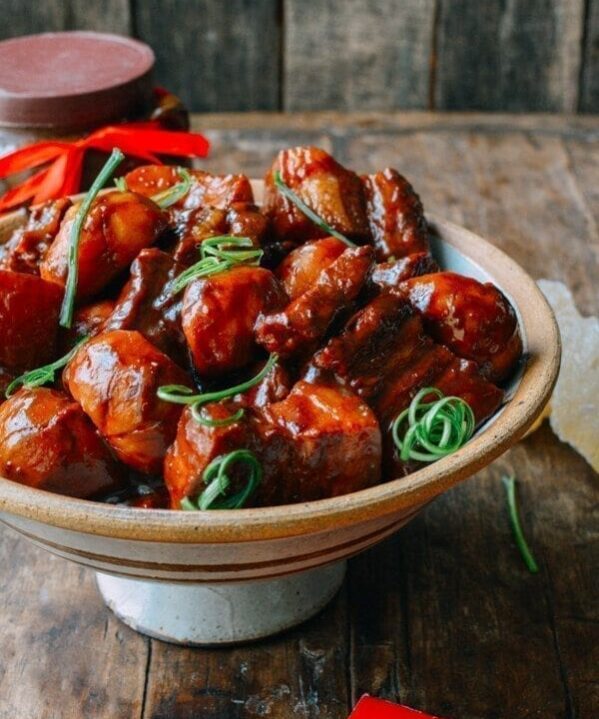Cantonese Pork Knuckles with Ginger and Vinegar (猪脚姜, pronounced jyū geuk gēung in Cantonese or zhū jiǎo jiāng in Mandarin) may not be the most well-known dish to the kids these days.
However, as recently as a generation ago, it was a must-have postpartum dish for new moms. Many of you have requested that we cover this traditional recipe on the blog, and we’ve finally answered the call!
The Anatomy of a Dish
The dish’s name captures its key ingredients: pig trotters (AKA pig feet) and pork knuckles (the pig’s foot and the portion of the leg that attaches to the foot, with the skin), ginger and vinegar. It also often includes hard-boiled eggs.
There are no small amounts in this recipe. It calls for 2 bottles of vinegar (yes you read that right) and a whopping one POUND of ginger.
The dish has a very intense flavor that isn’t for everyone. It’s almost like it’s more medicine than food, though my mother-in-law did make it occasionally just to enjoy it!
Bill remembers very well the strong smell of this dish simmering away on the stove. When I was developing this recipe, we put it to the smell and taste test. Did it match up with Bill’s memories of his Cantonese mother’s version?
Why Is This a Postpartum Staple for Cantonese Women?
According to traditional Chinese medicine, it has the ability to improve Qi, warm the blood, and expel cold and dampness. Many believe it speeds up recovery from childbirth and restores strength and vitality to the body.
Some Cantonese women also love it because all the collagen in the dish can improve skin texture, and the ginger improves circulation (rosy cheeks!).
According to Wikipedia (they seem to have an article for everything), the vinegar breaks down the calcium in the pork bones. Pregnancy and breastfeeding can deplete calcium in women’s bodies, so one of the main nutritional benefits of the dish is its high calcium content.
Ginger also contains Vitamin C, which can help bolster the immune system. The addition of eggs provides protein, which can help repair muscles.
It’s best to wait a few days after delivery to serve this to a new mom. 1 small bowl a day is sufficient, and the recipe should last for a week. For more complex cases, it’s best to wait longer, until a normal appetite returns. Be sure to consult your doctor about dietary recommendations before making this dish!
Did I Eat This After I Gave Birth to My Kids?
Good question! Bill’s mother cooked a huge pot of this for me when I had Sarah. But I just couldn’t take the strong, pungent taste of the vinegar and ginger.
I’m from Shanghai, so dishes like jiu niang (酒酿, fermented rice wine) soup with poached eggs, snow fungus soup with red dates, fish tofu soup, and a soup of pig trotters and peanuts were all more pleasing to my palate.
Long story short, I didn’t eat it! (Ironic, that I’m the one to bring this recipe to the masses, eh?)
Yes, Bill’s parents and visiting relatives enjoyed it instead of me. But while I wasn’t an expert in making this dish, I did a lot of research.
Indeed, when I had this bubbling on the stove, Bill instantly recognized the smell and flavor of his mother’s version from childhood. I’d say that’s a pretty big seal of approval!
There are many recipe variations from family to family, so feel free to make adjustments to my version.
Now that I’ve successfully tested this recipe for Pork Knuckles with Ginger and Vinegar, I feel as though I’ve gone through a rite of passage. Perhaps I’m ready to be a grandmother, however scary that thought is! To clarify, no grandkid(s) yet!
Recipe Notes: Read Before Cooking!
1. Choose the Right Cooking Vessel
To make this recipe, you must use a clay pot, enamel-coated Dutch oven, stainless steel pot, or any other non-reactive cookware. Do not use aluminum, cast iron, or copper cookware.
This recipe contains a lot of vinegar, and the acidity will ruin reactive cookware. It may also result in a metallic flavor in the final dish––definitely not healthy! If you’re unsure, look up whether your cookware is reactive or non-reactive.
2. Notes On Ginger
Fresh young ginger has a spicy flavor, but mature ginger is even spicier. Select ginger based on your tolerance level. Just know that old ginger is more potent! Do not use moldy ginger under any circumstances (i.e. do not try to cut away the moldy parts and salvage it).
Though it’s not 100% necessary, it’s best to dry out the ginger in the sun for a day. Slightly dried ginger is more absorbent. New moms are expected to eat the ginger along with the pork trotters, eggs, and vinegar!
When you’ve scraped the skin off the ginger, keep it! You can boil the skins in water to create a hand/foot soak that’s great for arthritis pain. My mother does this all the time.
Another optional step is to boil the ginger for 5 minutes to mellow it out. Drain and wipe thoroughly dry. Again, if you decide to do this, save the water you boiled the ginger in for a foot soak!
3. A Special Kind of Vinegar
One of the recipe’s key ingredients is this type of sweet vinegar (see photo below). This vinegar seems to be especially made for this dish, because I haven’t seen it used for anything else in my experience.
You’ll also need some regular Chinese black vinegar, which is more sour. I’ve seen ratios of sweet vinegar to sour vinegar range from 10:1 to 2:1. I suggest starting with a 10:1 ratio. Then you can adjust it according to your own tastes.
4. Cooking the Eggs
Recipes call for cooking the hard boiled eggs for about 30 minutes, until they turn into “铁蛋” or “metal eggs.” I personally wouldn’t advise it because I think this makes them harder to digest, but I have to mention it since it’s a “thing.”
I also don’t particularly like chalky eggs, so I minimize the cooking time for them. If you do want “metal eggs,” add the hard-boiled eggs in the last 30 minutes of cooking.
Cantonese Pork Knuckles with Ginger and Vinegar: Recipe Instructions
Use the back of a paring knife or spoon to scrape the skin off the ginger, keeping the ginger in large pieces.
Once peeled, rinse them clean and wipe them thoroughly dry. Lightly smash each chunk with the side of a knife or other flat, heavy tool.
In a clean, dry wok over medium heat, cook the ginger for 10 minutes. Be careful not to burn it. If any of the ginger burns, trim away the burnt spots, or the finished dish will be bitter.
Add the ginger chunks to a large non-reactive cooking vessel, along with the two types of vinegar.
Cover and bring to a boil. Once boiling, turn the heat down to medium. Simmer for 90 minutes. This is a good time to taste the vinegar mixture––free feel to add more black vinegar for tartness.
(Note: Some people traditionally prepare this vinegar & ginger base about two weeks before the baby’s due date. It can sit in the fridge, while the ginger pickles in the vinegar. Some have it out at room temperature, re-boiling it every week for 15 minutes over medium heat, but storing it in the fridge is safer. Be sure to wipe any condensation from the lid with a clean cloth, and keep the pot covered.)
While the vinegar and ginger are simmering, take a separate pot and add the pork. Cover it with cold water, and add 2 tablespoons Shaoxing wine. Bring to a boil and boil for an additional 3 minutes. Turn off the heat, drain, and rinse the pork. Set aside.
Once the vinegar and ginger have simmered for 90 minutes, stir in the pork. (If you prepared the vinegar and ginger base in advance, bring it to a boil before adding the pork.)
Cover and cook for another 60-90 minutes over medium heat. You’ll know it’s done when you can easily poke through the pork skin with a chopstick.
While the pig trotters and pork knuckles are cooking, boil the eggs. We came across this rigorously tested method Serious Eats. Bring 3 quarts of water to a boil in a large pot (it sounds like a lot, but it helps get the eggs to the right temperature to be easy to peel).
Lower the eggs into the boiling water, and boil for 30 seconds. Cover the pot, reduce the heat to low, and simmer for 11 minutes. Transfer to a bowl of ice water. Once cool, tap the eggs against the counter all over to crack the shell, and peel under a thin stream of running water.
Once the pig trotters have reached an ideal doneness, carefully submerge the peeled eggs and bring everything to a boil.
Turn off the heat, and let it sit overnight.
The next day, reheat, salt to taste, and serve hot.
Again this dish of Pork Knuckles with Vinegar and Ginger is a traditional dish, prepared for a very particular purpose! I hope you enjoyed learning about it!
Cantonese Pork Knuckles with Ginger and Vinegar
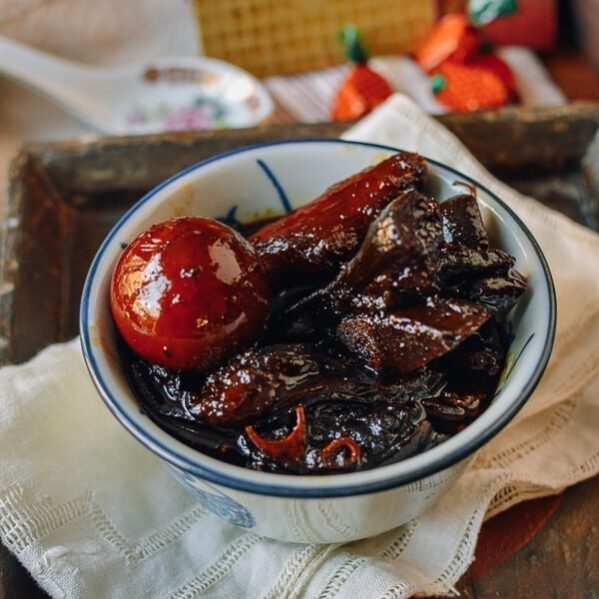
Ingredients
- 1 pound ginger (450g)
- 1200 ml Chinese sweet vinegar (5 cups)
- 120 ml Chinese black vinegar (1/2 cup)
- 1 pig trotter with shin (the pork knuckle; should total about 2 lbs/1kg)
- 2 tablespoons Shaoxing wine
- 6 hard boiled eggs
- salt (to taste)
Instructions
- Use the back of a paring knife or spoon to scrape the skin off the ginger, keeping the ginger in large pieces. Once peeled, rinse them clean and wipe them thoroughly dry. Lightly smash each chunk with the side of a knife or other flat, heavy tool.
- In a clean, dry wok over medium heat, cook the ginger for 10 minutes. Be careful not to burn it. If any of the ginger burns, trim away the burnt spots, or the finished dish will be bitter.
- Add the ginger chunks to a large non-reactive cooking vessel, along with the two types of vinegar. Cover and bring to a boil. Once boiling, turn the heat down to medium. Simmer for 90 minutes. This is a good time to taste the vinegar mixture––free feel to add more black vinegar for tartness.
- While the vinegar and ginger are simmering, take a separate pot and add the pork. Cover it with cold water, and add 2 tablespoons Shaoxing wine. Bring to a boil and boil for an additional 3 minutes. Turn off the heat, drain, and rinse the pork. Set aside.
- Once the vinegar and ginger have simmered for 90 minutes, stir in the pork. (If you prepared the vinegar and ginger base in advance, bring it to a boil before adding the pork.)
- Cover and cook for another 60-90 minutes over medium heat. You’ll know it’s done when you can easily poke through the pork skin with a chopstick.
- While the pig trotters and pork knuckles are cooking, boil the eggs. We came across this rigorously tested method Serious Eats. Bring 3 quarts of water to a boil in a large pot (it sounds like a lot, but it helps get the eggs to the right temperature to be easy to peel). Lower the eggs into the boiling water, and boil for 30 seconds. Cover the pot, reduce the heat to low, and simmer for 11 minutes. Transfer to a bowl of ice water. Once cool, tap the eggs against the counter all over to crack the shell, and peel under a thin stream of running water.
- Once the pig trotters have reached an ideal doneness, carefully submerge the peeled eggs and bring everything to a boil. Turn off the heat, and let it sit overnight. The next day, reheat, salt to taste, and serve hot.
